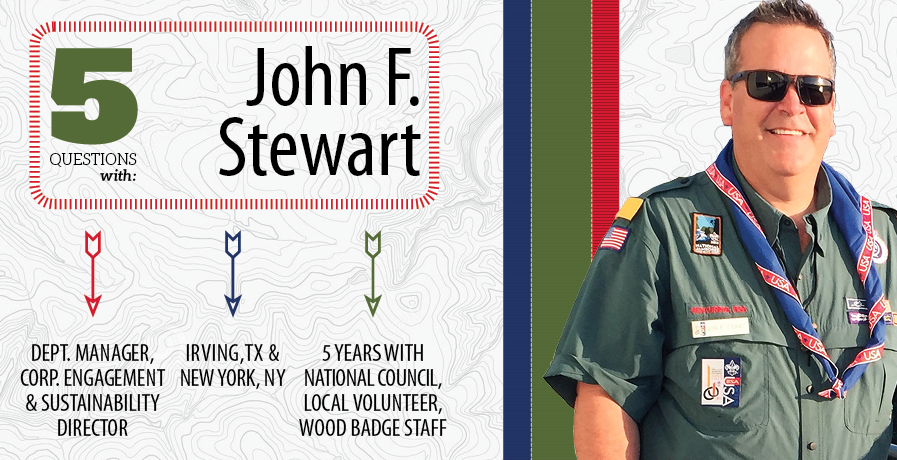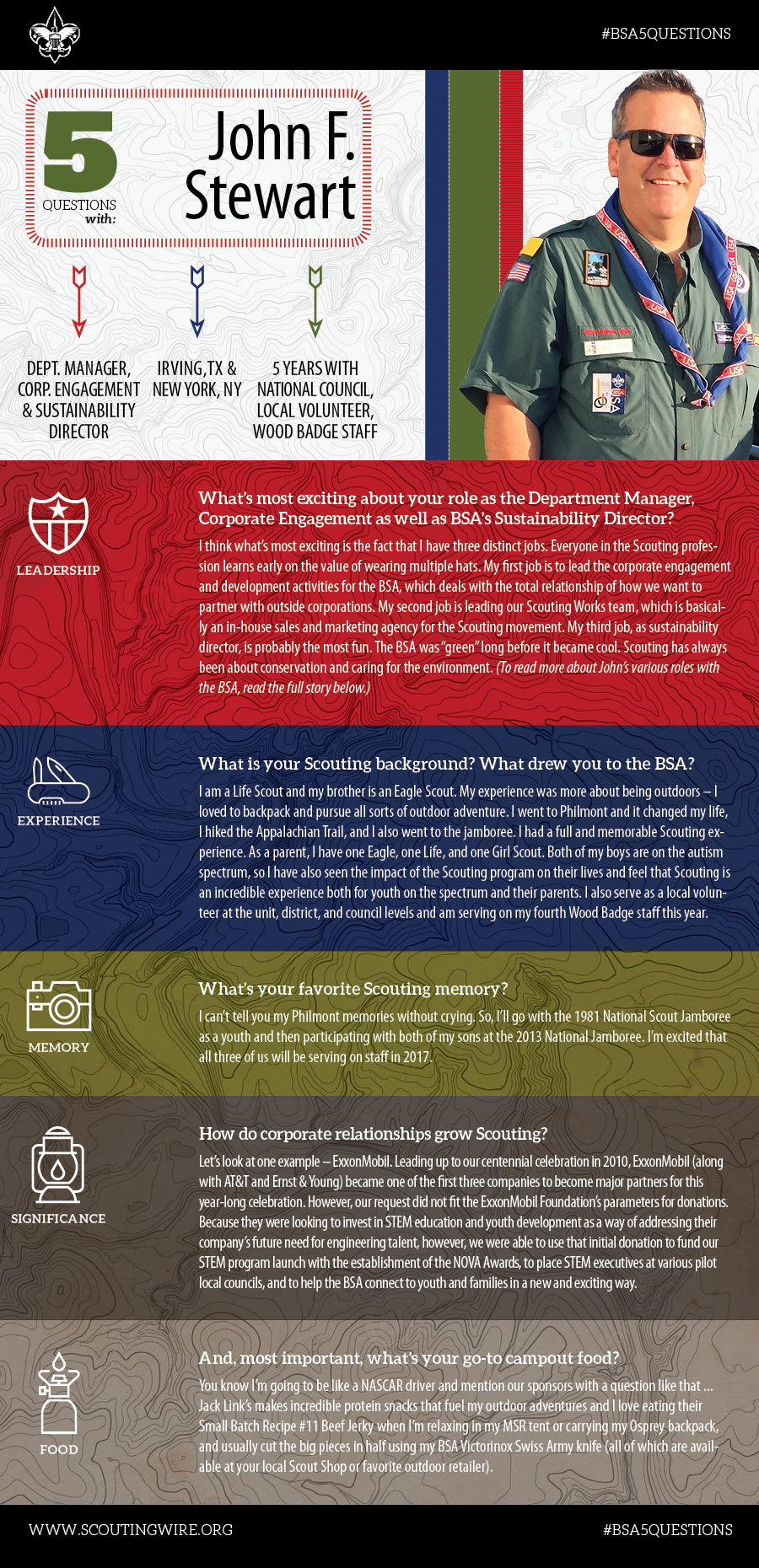
5 Questions with Corporate Engagement Dept. Mgr. and Sustainability Director, John F. Stewart
Whether he’s leading new relationships with outside corporations, heading up our in-house sales agency or spearheading new green efforts for the organization, the BSA’s top guy for corporate engagement and sustainability has his hands full with an array of jobs that are helping Scouting reach families and businesses far and wide. John F. Stewart is Scouting Wire’s newest 5 Questions featured employee and we’re here to decode what exactly the man with many hats does.
Check out the infographic below to read up on his role here at the BSA and discover what he can’t leave behind on his campouts!

What’s most exciting about your role as the Corporate Engagement Department Manager and as BSA’s Sustainability Director?
John: I think what’s most exciting is the fact that I have three distinct jobs. Everyone in the Scouting profession learns early on the value of wearing multiple hats: A district executive is charged with fundraising, membership growth, program delivery, and volunteer recruitment, and many are also assigned additional duties like camp director, popcorn sales staff lead, etc. The same can be true at the National Service Center.
My first job is to lead the corporate engagement and development activities for the BSA. If it deals with an outside corporation (public or private), it’s in my department’s wheelhouse. This includes our overall relationship management with companies like AT&T, Walmart, ExxonMobil, Polaris, etc.
Over the past four years, these efforts have generated over $80 million in support for the BSA. Having said that, I think it’s worth noting that there is a big difference between “development” and “engagement” and there is a reason we adopted Corporate Engagement as the department name. Development is just about raising money. Engagement is about the total relationship of how we want to partner with outside corporations.
In this regard, we also work with the local Scout executive as much as possible, since true engagement with the BSA means local involvement in funding, volunteerism, donated products and services, etc. The same way the BSA Foundation works with development directors in the local council on growing major gifts and individual donors, we work with local councils on growing relationships with corporations. Let’s face it, a huge majority of fundraising will always come from individuals. But corporations can give us more than just a financial donation. There are many corporate brands that can elevate our brand, or make us more relevant to youth or new volunteers.
Corporations have products and services that we need to grow Scouting. Since corporations are also constantly trying to grow their businesses, I love to show them how to use the Scouting platform to do just that. We are hosting a presentation at the National Annual Meeting for key local council leaders to understand how best to work with corporations in their area and the strategy and process to secure investment for Scouting. Hopefully, many Scout executives, development staff, and key volunteers will be able to join us.
My second job is leading our Scouting Works team (ScoutingWorks.com). Scouting Works is an in-house sales and marketing agency for the Scouting movement. We market advertising, media, and marketing opportunities to brands and companies. This team is not focused on corporate foundations or senior leadership at these companies like the CEO or owner, however. This team works directly with advertising agencies, brand marketers, and others to sell advertising and sponsorships and help create corporate partnerships.
This includes representing all three of our magazines, BSA’s digital properties and social media channels, events like NAM and the jamboree, and sponsorship and corporate donations for BSA properties and Scouting programs. We also work closely with BSA Licensing, National Purchasing, and the merchants from Supply on overall vendor and licensee engagement. The point is to make it as easy as possible for a brand marketer to work with the BSA. The Scouting Works office is in New York City with another nine team members at the National Service Center. This year, the Scouting Works team will generate over $5 million in revenue for the BSA (local and national) and help offset over $10 million in budget relief for the jamboree.
My third job at the BSA is probably the most fun. I was asked by Wayne Brock, the Chief Scout Executive at the time, to lead our movement’s sustainability initiatives. Sustainability is a big buzz word today, but it’s just a part of our DNA. We were “green” long before it became cool. Scouting has always been about conservation and caring for the environment. We have always raised up environmental stewards and champions. I like to say we have always been green, now we are moving to deep green (greentodeepgreen.org).
Today, sustainability means improving our facilities and operations to operate in a more efficient manner. It also means looking at ways we can use our programs and camp properties to reach a larger audience and get even more youth connected to nature. It means improving our own supply chain and how we can truly live the Scout Oath and Law in our business practices. We have had a number of Sustainability Summits and events over the past four years, produced a sustainability report, launched a Sustainability merit badge, published a resource kit for local councils to use as a Sustainability road map, and featured the incredible work being done at the National High-Adventure bases and the Summit. But the next real step is working with local councils to reach new donors, volunteers, and families due to BSA’s commitment to be an environmental leader.
I would encourage councils to join us at NAM for a Spark session on this area or in October at the Sustainability Summit, which will be held at the Orange County Council’s Irvine Ranch Outdoor Education Center in California. We will also be hosting a one-day LeaderSHIFT event from the Summit for local councils to participate online like we did last fall. As part of our sustainability efforts, I also oversee the BSA conservation and environment task forces and programs like the William T. Hornaday Program, relationships with Leave No Trace, Tread Lightly, and the National Park Service.
What is your Scouting background? What drew you to the BSA?
John: I am a Life Scout and my brother is an Eagle Scout. And to be honest, I never really cared to be an Eagle or have it as a goal, so I’m surprised to this day that I made it that far. My brother was on a fast track to Eagle and left the program the day he earned it. My experience was more about being outdoors. I’ve spent over 400 nights in a tent and loved to backpack and participate in all sorts of outdoor adventures.
I went to Philmont and it changed my life, hiked the Appalachian Trail, and also went to the 1981 National Scout Jamboree. I had a full and memorable Scouting experience. As a parent, I have one Eagle, one Life, and one Girl Scout. Both of my boys are on the autism spectrum so I have also seen the impact of the Scouting program on their lives and feel that Scouting is an incredible experience both for youth on the spectrum and, especially, for their parents. I also serve as a local volunteer at the unit, district, and council levels (Cubmaster, Troop Committee, District Committee Chair, Assistant District Commissioner, etc.) and am serving on my fourth Wood Badge staff this year.
What’s your favorite Scouting memory?
John: I can’t tell you my Philmont memories without crying. So I’ll go with the National Jamboree as a youth in 1981 and then with participating with both of my sons in 2013. I’m excited that we will all three be serving on staff in 2017.
How do corporate relationships grow Scouting?
John: Let’s look at one example – ExxonMobil. Leading up to the centennial celebration in 2010, the BSA Board of Directors approved a policy change that would allow corporations to effectively “sponsor” Scouting and for the BSA to officially “endorse” corporations. The first three companies to become major partners for the centennial were AT&T, Ernst & Young and ExxonMobil. When it came time for the actual monetary contribution, ExxonMobil made the decision that it would fund the commitment from their corporate foundation. The problem was, the foundation had three areas for distributing funds and our request did not fit their parameters. However, they were looking to invest in STEM education and youth development.
ExxonMobil’s CEO and past BSA President Rex Tillerson said their reason for investing in STEM was their company’s future need for engineering talent. At this point in our organization, the BSA had no awareness or knowledge of STEM. We had a bunch of individual program areas that could be considered STEM, but no focus. That initial donation funded our STEM program launch with the establishment of the NOVA Awards, facilitated the placement of STEM Executives at various pilot local councils, and helped the BSA connect to youth and families in a new and exciting way. We discovered that every parent wants their kid to excel in science, technology, engineering, and math. We discovered that STEM was a great way to grow Scouting. This is what allowed volunteers like April McMillan and Trent Nichols to develop the STEM Scouts program that is a major priority today. So, that’s just one way a company can help Scouting grow.
And, most important, what’s your go-to campout food?
John: You know I’m going to be like a NASCAR driver and mention our sponsors with a question like that … Jack Link’s makes incredible protein snacks that fuel my outdoor adventures and I love eating their Small Batch Recipe #11 Beef Jerky when I’m relaxing in my MSR tent or carrying my Osprey backpack and usually cut the big pieces in half using my BSA Victorinox Swiss Army knife (which are all available at your local Scout Shop or favorite outdoor retailer).
Want to Be Our Next Featured Employee?
Are you an employee at the BSA who wants to give Scouting nation insight into their role here at the BSA? Or know any outstanding employees you’d like to see featured? Give us a shout in the comments below explaining who you think would fit the bill!



